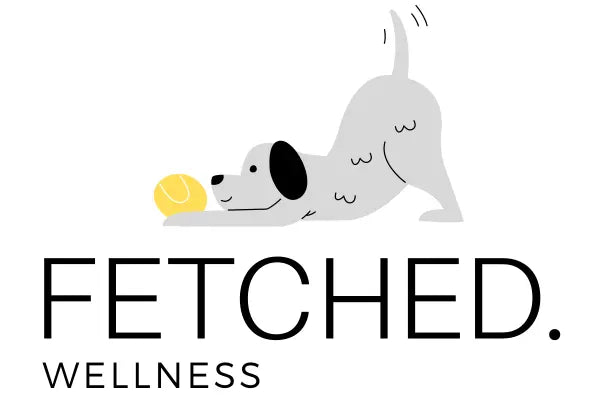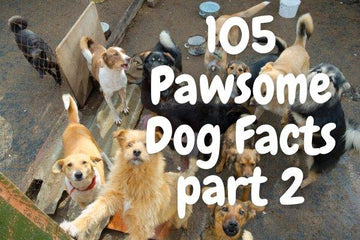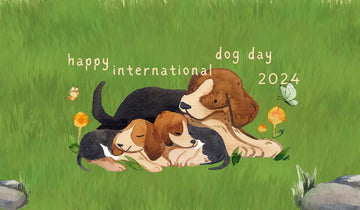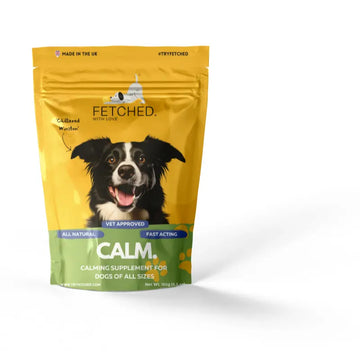And here is the second part of the 105 pawsome and amazing facts about dogs article. Check part 1 for more amazing facts.
53. Dogs are capable of dreaming.
Like humans, dogs have sleep cycles that include periods of deep sleep and REM (rapid eye movement) sleep. REM sleep can be identified by their twitching, slight jerks and paw movements.
This means they are having a deep sleep and feel comfortable in the environment they are in. (Source)
54. The Chihuahua is the smallest dog breed.
The tiny Chihuahua (as small as the size of the dollar bill) holds the title for the smallest dog breed in the world. They're named after Chihuahua, a state in Mexico, and are known for their feisty temperaments and loyalty to their owners.
55. Pit Bull is not an official breed but rather a term for several different bull breeds.
The term 'Pit Bull' is often used to describe a type of dog characterized by certain physical traits, but it's not a breed itself. It can refer to either American Pit Bull Terriers, American Staffordshire Terriers, or Staffordshire Bull Terriers, or any mix of these breeds. (Source)
56. Dogs have a unique scent print.
Just like human fingerprints, dogs have a unique scent that is specific to that particular dog. The scent comes from the dog's anal glands and is one way dogs recognize each other.
57. Rottweilers were originally dogs bred to drive cattle to market.
In the past, they were also used to pull carts for farmers and butchers for example. They were great at guiding cattle as they have a natural gathering style with a strong desire to control, features that are apparent even today when the dog is herding animals or playing with other dogs.
58. Dogs are capable of understanding some human language.
Studies have suggested that dogs can learn and respond to hundreds of words and commands. One Border Collie named Chaser was reported to understand over 1,000 words, effectively learning a simple language with her trainer. (Source)
59. Leonbergers were bred to mimic the lion in the town crest of Leonberg, Germany.
The Leonberger, a giant breed, was developed as a “symbolic breed” in the 19th century to resemble the lion on the Leonberg town crest.
They were bred by crossing a Newfoundland, Saint Bernard, and a Pyrenean Mountain dog. Today they make an excellent swimmer and are sometimes used as rescue dogs.

60. Dogs are believed to see in a color spectrum of blues and yellows.
While it was once thought that dogs saw in black and white, recent studies suggest that they actually see the world in blues and yellows.
They can't distinguish between red and green, which likely appear as shades of gray to them. For this reason they would prefer dog toys in blues and yellows!(Source)
61. Greyhounds are the oldest purebred domesticated dog, dating back to the pharaohs of ancient Egypt.
Depictions of Greyhound-like dogs have been found on Egyptian tombs dating back to 2900 B.C. They've been bred for speed and were held in high regard by the ancient Egyptians. They were also often mummified and buried in the tombs with their owners. (Source)
62. The phrase "raining cats and dogs" has uncertain origins.
One theory is that it originated in 17th-century England when heavy rain would wash out city streets, carrying along many stray dogs that have drained in the sewers or canals. However, its true origins remain uncertain.
63. Dogs' wet noses help them detect scents.
A dog's nose secretes a thin layer of mucus that absorbs scent chemicals. This enhances their already impressive ability to detect smells. When a dog licks its nose, it's essentially "tasting" the scent to gain more information. A wet nose is also indication of the health of a dog. (Source)
64. The popular "dog days of summer" phrase has ancient roots.
The phrase dates back to the Romans who named these hot, humid days after the dog star Sirius, which is the brightest star in the constellation Canis Major (Large Dog).
They believed that when Sirius rose just before the sun in late July, its brightness added to the sun's heat to create a stretch of hot and sultry weather. (Source)
65. The Akita breed is a national monument in Japan.
The Akita is one of Japan's oldest and most revered breeds. They're considered a national treasure and monument, and in the past were owned exclusively by the imperial family. (Source)

66. All purebred puppies of the same breed look similar, but as they age, their looks will change due to environmental factors such as diet, exercise, and grooming.
While purebred puppies may look nearly identical, individual differences in lifestyle and care can affect their appearance as adults.
67. The Whippet breed is often referred to as "the poor man's racehorse".
The Whippet breed was developed in 19th century England to chase rabbits for sport by the working class in England. (Source)
68. The Xoloitzcuintli (or Xolo) is one of the oldest and rarest hairless dog breeds.
Dating back over 3,000 years, the Xoloitzcuintli was considered sacred by the Aztecs, Toltecs, and Maya. They are quite rare today, but interestingly not all Xolos are actually born hairless. They can also come in a fur coated variety. (Source)

69. The Belgian Malinois is one of the top breeds used in police and military roles.
This breed is known for their intelligence, agility, and versatility. The Belgian Malinois is often used for tasks including detection of explosives and narcotics, search and rescue, and tracking humans. (Source)
70. 900 million dogs live around the world.
This is the latest estimate and about 17-24% of them live as pets in developed countries (Source)
71. Dogs are omnivores.
While many people assume dogs are carnivores, they are actually omnivores. This means they can eat a variety of foods, including meat, vegetables, and grains, just like a human would. Like our diet, nutritional intake needs to be balanced for them to receive the necessary nutrients.
72. Puppies and adult dogs require different diets.
Puppies usually require a diet high in protein and calories to help their growth. On the other hand, adult dogs may need fewer calories and a balanced mix of protein, carbohydrates, and fats. The exception is if you are looking to bulk up an adult dog, in which case you would be looking for a dog feed rich in protein.
73. Dogs also need a balanced diet to stay healthy.
A balanced diet for dogs typically includes a mix of protein (from meat or plant sources), carbohydrates, fats, vitamins, and minerals. A deficiency or excess of any of these nutrients can lead to health problems.
74. Some human foods are toxic to dogs.
Certain foods that are safe for humans can be toxic or even deadly for dogs. Some of these are chocolate, grapes, raisins, onions, garlic, alcohol, and caffeine. These are toxic to them as they cannot break them down and it can lead to accumulation in the liver or cause pancreatitis.
75. Dogs can have food allergies or sensitivities.
Just like humans, dogs can have food allergies or intolerances. Common allergens include beef, dairy, wheat, eggs, chicken, lamb, soy, pork, rabbit, and fish. Some of the symptoms of allergies and food intolerances can be subtle, and other quite serious.
76. Portion control is important for a dog's health.
Overfeeding can lead to obesity, which is linked to various health issues in dogs, including heart disease, diabetes, and arthritis. It's important to follow the recommended nutritional guidelines based on a dog's age, breed, and size. Exercise is also important for a dog’s health and to prevent obesity.
77. Rin Tin Tin was a famous canine actor in the 1920s and 1930s.
Rin Tin Tin, a male German Shepherd, was rescued during World War I by an American soldier who saw how clever he was. Rin Tin Tin then went on to star in 27 Hollywood films and became an international Hollywood star. (Source)

78. Toto from "The Wizard of Oz" was played by a female Cairn Terrier named Terry.
Terry appeared in 16 different movies but is best known for her role as Toto. Despite the fame, Terry's salary was reportedly only $125 per week. (Source)
79. Lassie, one of the most famous TV dogs, was played by not one, but several Rough Collies who looked identical.
The original Lassie character was played by a dog named Pal. After Pal's death, his descendants played the role of Lassie in later productions.
80. The "101 Dalmatians" movie caused a surge in the popularity of the breed.
After the release of the animated and live-action movies, many people impulsively bought Dalmatians. Unfortunately, many of these dogs were given away and ended up in dog shelters when owners were unprepared for the breed's specific needs.
81. The 101 Dalmatians story was inspired by this house in London, UK.
On the road across from Primrose Hill in central London, lies the house that is said to have inspired Dodie Smith’s 101 Dalmatians book.
Roger, the main character in the movie has a similar study where he is seen to be playing the piano and singing about Cruella de Vil. The house recently went on for sale for over £8m! (Source)

82. Drones are used to monitor and train dogs.
In some instances, drones have been used to train dogs for various activities, from simple fetch games to more complex tasks like herding or search and rescue training. The drone can move in ways that humans can't, providing a unique training experience. It can also be used to monitor a dog’s location when exercising them remotely. (Source)
83. Dental health is crucial for dogs.
Like humans, dogs can develop periodontal disease from not maintaining proper oral hygiene. Regular dog teeth cleaning, dental powders and dental chews can help keep their mouth healthy.
84. Spaying or neutering your dog can prevent certain health issues.
These procedures can prevent health problems like uterine infections and breast tumors in females, and testicular cancer and prostate problems in males. They can therefore promote longevity in your dog.
85. Dogs can suffer from mental health issues, such as anxiety or depression.
Signs can include changes in appetite or sleeping habits, decreased interest in play, or unusual behaviors like excessive panting, licking or chewing. There is now relaxing music for dogs that has been shown to ease some of these anxiety symptoms.
86. Heartworm is a serious and potentially deadly condition for dogs.
Transmitted by certain mosquitoes, heartworms can cause severe lung disease, heart failure, and damage to other organs. Regular heartworm check and preventative treatment can protect your dog from this disease and therefore extend their lifespan.
87. Dogs can also get Lyme disease.
Transmitted through certain tick bites, Lyme disease can cause fever, loss of appetite, painful or swollen joints, lameness, and more in dogs.
Tick prevention is essential, especially in areas where Lyme disease is prevalent such as areas across the easter U.S., but also places like southern England and most of central and Eastern Europe. (Source)

88. Dogs' ears should be cleaned and checked regularly for infections.
Ear infections can be common in dogs, especially breeds with floppy ears. This position prevents airflow and therefore makes the ears a perfect breeding ground for pathogens. Regular cleaning and checking for signs of infection (such as redness, swelling, or bad smell) can help keep your dog's ears healthy.
89. Some dog breeds are prone to certain skin conditions.
Skin conditions like dermatitis can be more common in certain breeds. These breeds include Bulldogs, Shar-Peis, and Pugs, as the skin folds can trap moisture. In addition to this, other breeds like Dalmatians, Boxers and West Highland White Terriers are genetically presdisposed to skin conditions.
Regular grooming, a balanced diet, and in some cases, medical treatment can help manage these conditions.
90. Head tilting might be a sign of empathy.
I was always taught in school that dogs tilt their heads to the side when we speak as a sign of empathy - they're showing us they're engaged in our conversation and actively listening.

91. A dog's eyes can say a lot about their emotional state.
Similar to humans, dilated pupils can indicate a dog is scared or aroused. Narrow pupils may mean the dog is aggressive or unfriendly. If a dog looks stares at you for a prolonged time, that may also be interpreter as an ‘eye challenge’ and is considered to be rude. It could also make them react aggressively!
92. The position and movement of a dog's ears can also signal their mood.
Ears held tightly back against the head may indicate a dog is scared or feeling submissive, while ears perked upright could show that the dog is alert and attentive.
93. Yawning in dogs is a sign of pacification, not a sign of tiredness.
Dogs often yawn as a form of communication, either to show stress, fear, or confusion. Yawning is also a common calming signal, in cases where a dog will actively try to pacify itself or another individual.
94. There are now pet specific airlines.
Airlines such as K9 Jets run dedicated dog owner flights where you fly with other dog owners inside a private jet. Your dog can either have their own seat, or sit on the floor. This is great for relocating or for simply traveling with your pet if you don’t want him to fly in the cargo hold.
95. Dogs may sneeze during play to show they're not being aggressive.
This is often observed during rough play sessions. It's a dog's way of saying, "I'm just playing, and I don't intend to hurt you."
96. The "play bow" is the universal dog signal inviting play from others.
When a dog goes into a "play bow" (front end down, back end up), it's an invitation to another dog, animal, or human that they want to play. Have you ever seen your dog do this?
97. Dogs showing their belly might be asking for belly rubs or showing submission.
When a dog exposes its belly, it's a vulnerable position as that is where their important organs lay. This position can can mean the dog feels comfortable and trusts you. In other contexts, it can be a sign of submission.
If you see your dog sleep with their belly up it also means that they are very comfortable in the environment they are in and they are likely having a healthy and deep sleep!

98. Why do dogs eat grass?
It is thought that dogs eat grass if they’re having tummy problems as they know it’s rich in fibre, which can help their digestion. Eating grass for dogs is considered harmless unless done excessively or if the grass is treated with harmful chemicals. Unlike humans, who can’t digest the grass, dogs are equipped with the necessary digestive enzymes to do so.
99. A raised paw can have multiple meanings.
Depending on the context, a raised paw might be a sign of anticipation, a request, or uncertainty.
100. Licking can be a sign of affection, but it can also signal stress.
Dogs often lick people they're comfortable with as a sign of affection. Furthermore, a dog may lick your skin because they like the often salty taste. However, excessive licking can also be a sign of stress or anxiety.
101. Dogs can experience stress during a house move.
Just like humans, dogs can feel the stress of a move. Changes in routine and unfamiliar environments can be unsettling to them. It's important to maintain their routine as much as possible during the move.
102. Pugs can be prone to certain health issues.
Pugs are brachycephalic which means their build can cause them to experience breathing difficulties and are more susceptible to heatstroke compared to other breeds.
103. Scooby Do is modelled on the Great Dane breed.
No wonder he was so massive in the Scooby Do movies! His size and features are modelled on the Great Dane breed. He made a great companion and was best friend of Shaggy Rogers, the detective.

104. Circadian rhythms exist in dogs.
Just like in humans, circadian rhythms that tell their organism when to sleep and when they should be awake, also exist in dogs. Dogs are however very adaptable and can adjust their sleep pattern.
Dogs are typically most active in the morning and evening, with periods of rest in between.
105. A dog’s sleep position reveals a lot about their personality and current mental state.
For example, dogs may sleep curled up if they are anxious or feel unsafe, as this position protects their vital organs. If a dog feels safe they might sleep on their side with the paws out or belly up.
If they sleep in the lion’s pose with their heads on top of their paws this means they are resting, but also on alert and ready to jump up at a moment’s notice.
There you go, we've now gone through all 105 pawsome and interesting facts! Are there any other facts you want to share with us?









